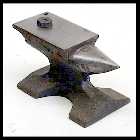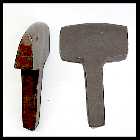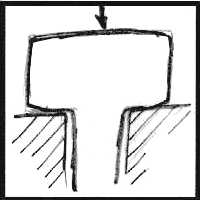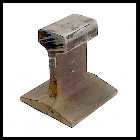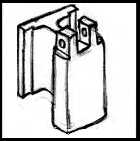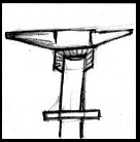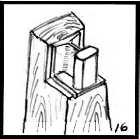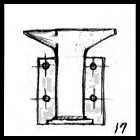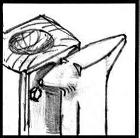guru : |
Tonights demo is on making tools out of RR-rail. Most of this is stuff for the beginner or the scrounger. There may be some ideas for the rest of you too. Please pardon my spelling/typing tonight. Been up for about 30 hours or so. . | |||
guru : |
|
|||
guru : |
Modern Rail road rail is a medium to high carbon steel (aprox 1075). | |||
guru : |
Pre 1865 rail is lower quality and some is actualy wrought iron. | |||
guru : |
|
|
||
guru : |
This little 6" anvil is made from some old pre 1865 steel. It has a spring steel top plate welded on. The bushing that fits the round hardy hole is made from a 1/2" bolt. It has a through hole and impression to support a #6 Capwell nail for puttin initials on the faces of the head. | |||
guru : |
The entire anvil was made for making horse shoe nail rings. Seems I used to make the anvils for $15 :) | |||
guru : |
In general RR rail makes a lousey anvil. We will get into that latter. | |||
guru : |
|
a fuller. | ||
guru : |
Heavy rail has about a 3/4" web and is great for the beginner making anvil tools. | |||
guru : |
|
|||
guru : |
This fuller was sawn off the end of a piece of 140# rail. Rail is measured in the pounds per yard, not foot like structural steel. | |||
guru : |
|
|
||
guru : |
Very little forging is required to make a fuller from rail. | |||
guru : |
|
|
||
guru : |
Rail is just high enough carbon that if water quenched while overheated it will crack. So I oil quench tools made from rail. | |||
guru : |
|
|||
guru : |
Here you can see the very little work required to finish this tool. | |||
guru : |
|
|
||
guru : |
Other anvil tools can be sawn or torch cut very close to shape. | |||
guru : |
After cutting two fullers off the opposite ends of a short piece of rail I had a handy bench anvil. | |||
guru : |
|
|
||
guru : |
Notice the difference in the rail sizes. | |||
guru : |
|
|||
guru : |
Rail can make a relatively low cost power hammer ram. The steel is hard enough not to need a seperate die. | |||
guru : |
However, the tapered flange must be machined or ground parallel to the back. | |||
guru : |
The carbon steel in rail is excellent for making stakes. Here a stake is made out of the top section and welded to a piece of mild steel shafting. | |||
guru : |
|
|
||
guru : |
Earlier I said that rail makes a lousy anvil. Any of you that have tried it know that it is very springy and the curved face can take a LOT of work to dress. | |||
guru : |
The springyness is due to the designed in flexibility of the rail. | |||
guru : |
|
|||
guru : |
If you turn a piece on end and weld it to a flange it is easy to get 9 to 12 inches of rigid MASS under your hammer. | |||
guru : |
It is a small target but it is not springy therefore it is much better for forging. | |||
guru : |
|
|
||
guru : |
With a little welding and grinding that small target can be improved. A small anvil built this way gives you the kind of rigidity you expect from a 100 poind or more anvil at 1/5 the weight. | |||
guru : |
|
|||
guru : |
The final image is a little armoures anvil with a dishing bowl carved into the stump. A handy combinations setup. | |||
guru : |
On caution when working with rail. Used rail often has cracks and almost always has cold shuts where the surface has been extruded over the original surface from years and years of heavy frieght rolling of the rail. | |||
guru : |
|
|
|
|
guru : |
Any questions, suggestions or comments. |
|||
SmithinScout : |
can u make a hardie like you did the fuller? | |||
Ten-Hammers : |
You mill the anvil face, or grind Guru? | |||
dimag : |
Should you anneal the rail surface before attempting to cut it Jock,will it be work hardened from the wheels of the train? | |||
Jim-C : |
Can rail be cut in a band saw? | |||
guru : |
Yes. You would want to upset the base a little more or start with a slifhtly thicker cut and draw the shank down a little. The steel will harden plenty well for a hardy. | |||
SmithinScout : |
how would you cut the groove on the swage block? | |||
guru : |
I cut mine with a band saw with a good quality blade and had no problem. Unless you did a first class job heating the piece to anneal it you would be likely to make it worse. | |||
guru : |
Scout, you heat up the swage, drop it in the hardy hole and pound a piece of round bar into it. | |||
SmithinScout : |
when making a small anvil like the first example, wuld the curve of the rail allow a groove to fill with weld to weld a top plate onto the top of the rail? | |||
Leah : |
Guru, what kind of oil do you use for a quench? Do you use warm oil? | |||
Steve-C : |
Guru do you know how you identify the difference between the different years ( carbon) content by site | |||
ironman213 : |
guru, while your talking about railroad track, i've seen it welded on the tracks before and i heard the yuse a thermite substance to weld it, would this work for welding large pieces or cutting them around the forge? | |||
guru : |
Scout its alsmost impossible to weld all the way accros. This was a little light duty wire bending anvil. | |||
SmithinScout : |
ok yeah it would be a lot of welding hehe kind of impracticle | |||
Jim-C : |
A cut in the top of a work hardened rail could be started with a die grinder & cut off wheel. | |||
guru : |
No. I would have to spark test or try to harden a piece. The old wrought rail I have is easy to tell. Looks like a piece of wood and torches like a stack of rusted plate. | |||
guru : |
Thermite was used extensively by the rail roads but it was also used in foundries for repairing large castings. Thermite is only good for welding, not cutting (expept in military demolition which is not looking for clean or controlled results). | |||
Bill-Epps : |
Jock I have made sevrel small anvils from switch track (7in tall) that came out real good ended up about 40 lbs with 1/2 sq. hardy hole | |||
LINKS: |
||||


